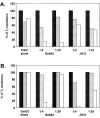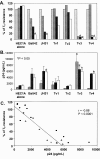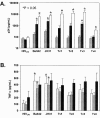Trichomonas vaginalis-induced epithelial monolayer disruption and human immunodeficiency virus type 1 (HIV-1) replication: implications for the sexual transmission of HIV-1
- PMID: 15972505
- PMCID: PMC1168584
- DOI: 10.1128/IAI.73.7.4155-4160.2005
Trichomonas vaginalis-induced epithelial monolayer disruption and human immunodeficiency virus type 1 (HIV-1) replication: implications for the sexual transmission of HIV-1
Abstract
The objective of this study was to evaluate potential mechanisms of Trichomonas vaginalis involvement in human immunodeficiency virus type 1 (HIV-1) transmission. Polarized monolayer integrity of primary cervical and prostate epithelial cells or cell lines cultured with T. vaginalis was measured by monitoring transepithelium resistance. The effect of T. vaginalis isolates on HIV-1 passage through polarized epithelial cell monolayers was evaluated for HIV-1 p24gag in the basolateral supernatants. Coincubation with T. vaginalis isolates induced disruption of monolayer integrity and resulted in passage of virus to the basolateral side of the monolayer. Furthermore, there was isolate variability in which two isolates induced greater monolayer damage and increased HIV-1 passage than did the other two isolates. Coincubation of T. vaginalis isolates with acutely HIV-1-infected peripheral blood mononuclear cells enhanced HIV-1 replication. This enhancement was associated with cellular proliferation and activation, as well as with tumor necrosis factor alpha production. In contrast to the monolayer disruption, the effect of T. vaginalis on HIV-1 replication was not isolate dependent. Thus, two mechanisms have been identified that could contribute to the epidemiologic association of trichomoniasis with the sexual transmission of HIV-1. (i) T. vaginalis disruption of urogenital epithelial monolayers could facilitate passage of HIV-1 to underlying layers. (ii) Activation of local immune cells by T. vaginalis in the presence of infectious HIV-1 might lead to increased viral replication. Collectively, these data suggest the need for more vigilant efforts in the diagnosis and treatment of T. vaginalis in women and men, especially in countries with a high prevalence of HIV-1.
Figures



Similar articles
-
Cervical and prostate primary epithelial cells are not productively infected but sequester human immunodeficiency virus type 1.J Infect Dis. 2001 Apr 15;183(8):1204-13. doi: 10.1086/319676. Epub 2001 Mar 13. J Infect Dis. 2001. PMID: 11262202
-
Human genital epithelial cells capture cell-free human immunodeficiency virus type 1 and transmit the virus to CD4+ Cells: implications for mechanisms of sexual transmission.J Infect Dis. 2003 Nov 15;188(10):1473-82. doi: 10.1086/379248. Epub 2003 Oct 31. J Infect Dis. 2003. PMID: 14624372
-
Trichomonas vaginalis infection and human immunodeficiency virus acquisition in African women.J Infect Dis. 2008 Feb 15;197(4):548-54. doi: 10.1086/526496. J Infect Dis. 2008. PMID: 18275275
-
Trichomoniasis--an important cofactor of human immunodeficiency virus infection.Przegl Epidemiol. 2013;67(1):47-50, 131-4. Przegl Epidemiol. 2013. PMID: 23745375 Review. English, Polish.
-
Global epidemiology and control of Trichomonas vaginalis.Curr Opin Infect Dis. 2008 Feb;21(1):56-64. doi: 10.1097/QCO.0b013e3282f3d999. Curr Opin Infect Dis. 2008. PMID: 18192787 Review.
Cited by
-
Infinity war: Trichomonas vaginalis and interactions with host immune response.Microb Cell. 2023 Mar 30;10(5):103-116. doi: 10.15698/mic2023.05.796. eCollection 2023 May 1. Microb Cell. 2023. PMID: 37125086 Free PMC article. Review.
-
Diagnosis and Management of Trichomonas vaginalis: Summary of Evidence Reviewed for the 2021 Centers for Disease Control and Prevention Sexually Transmitted Infections Treatment Guidelines.Clin Infect Dis. 2022 Apr 13;74(Suppl_2):S152-S161. doi: 10.1093/cid/ciac030. Clin Infect Dis. 2022. PMID: 35416973 Free PMC article. Clinical Trial.
-
Association of Female Genital Schistosomiasis With the Cervicovaginal Microbiota and Sexually Transmitted Infections in Zambian Women.Open Forum Infect Dis. 2021 Aug 22;8(9):ofab438. doi: 10.1093/ofid/ofab438. eCollection 2021 Sep. Open Forum Infect Dis. 2021. PMID: 34557562 Free PMC article.
-
Nosocomial Infections: Do Not Forget the Parasites!Pathogens. 2021 Feb 19;10(2):238. doi: 10.3390/pathogens10020238. Pathogens. 2021. PMID: 33669761 Free PMC article. Review.
-
Synthesis and preliminary in vitro activity of mono- and bis-1H-1,2,3-triazole-tethered β-lactam-isatin conjugates against the human protozoal pathogen Trichomonas vaginalis.Med Chem Res. 2014;23(8):3671-3680. doi: 10.1007/s00044-014-0956-6. Epub 2014 Feb 22. Med Chem Res. 2014. PMID: 32214766 Free PMC article.
References
-
- Andreana, A., S. Gollapudi, C. H. Kim, and S. Gupta. 1994. Salmonella typhimurium activates human immunodeficiency virus type 1 in chronically infected promonocytic cells by inducing tumor necrosis factor-alpha production. Biochem. Biophys. Res. Commun. 201:16-23. - PubMed
-
- Bernier, R., B. Barbeau, M. J. Tremblay, and M. Olivier. 1998. The lipophosphoglycan of Leishmania donovani up-regulates HIV-1 transcription in T cells through the nuclear factor-kappaB elements. J. Immunol. 160:2881-2888. - PubMed
-
- Brown, M. T. 1972. Trichomoniasis. Practitioner 209:639-644. - PubMed
MeSH terms
Substances
LinkOut - more resources
Full Text Sources
Other Literature Sources
Medical

